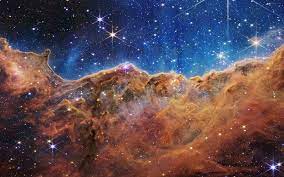
A Remarkable Discovery in the Cosmos: James Webb Space Telescope’s Latest Images
Key Highlights:
- The James Webb Space Telescope (JWST) has captured breathtaking images of a stellar nursery in the Large Magellanic Cloud (LMC), a satellite galaxy of our Milky Way.
- Utilizing the Mid-Infrared Instrument (MIRI), the telescope reveals intricate details of warm dust and gas in the nebula known as N79.
- The images showcase regions full of ionized hydrogen, indicating active star formation.
- A similar phenomenon has been observed in the Small Magellanic Cloud (SMC), another satellite galaxy, where the JWST imaged the star-forming region NGC 346.
- The colors in the images represent various processes: red for warm dust and blue for polycyclic aromatic hydrocarbons.
Exploring the Wonders of the Universe with the James Webb Space Telescope The James Webb Space Telescope, the most advanced space observatory to date, has once again expanded our understanding of the universe. By capturing stellar nurseries in nearby satellite galaxies, the JWST provides insights into the processes of star formation and the complexity of interstellar matter.
The Large Magellanic Cloud and Its Secrets
The Large Magellanic Cloud (LMC) is one of the Milky Way’s largest satellite galaxies. Here, the JWST’s MIRI instrument has focused on the nebula N79, revealing three giant molecular clouds teeming with ionized hydrogen – a key ingredient in the birth of new stars. This region, N79 South, showcases the dynamic environment where stars come to life amidst dust and gas.
NGC 346 in the Small Magellanic Cloud
Similarly, the JWST has shed light on NGC 346, a vibrant star-forming region in the Small Magellanic Cloud (SMC). This image, taken in the mid-infrared spectrum, highlights cool gas and dust, contrasting with previous images taken by the Hubble Space Telescope in the optical wavelength. The varied emissions captured by the JWST paint a detailed picture of the star-forming processes occurring within NGC 346.
The Colorful Palette of the Cosmos
The colors in these images are not just visually stunning; they carry significant scientific information. In the NGC 346 image, for instance, blue represents silicates and polycyclic aromatic hydrocarbons, while red signifies warm dust energized by the brightest stars in the region. These color variations help astronomers understand the different elements and processes at play in these star nurseries.
The Impact of the James Webb Space Telescope
The JWST’s contribution to space exploration and science cannot be overstated. Its ability to capture images in both the near-infrared and mid-infrared spectra provides a comprehensive view of celestial objects, allowing for a more complete understanding of their nature and behavior.
Summary
The James Webb Space Telescope continues to revolutionize our knowledge of the universe. Its latest images of stellar nurseries in the Large and Small Magellanic Clouds are not just a feast for the eyes but a treasure trove of information for scientists exploring the mysteries of star formation and interstellar matter.










